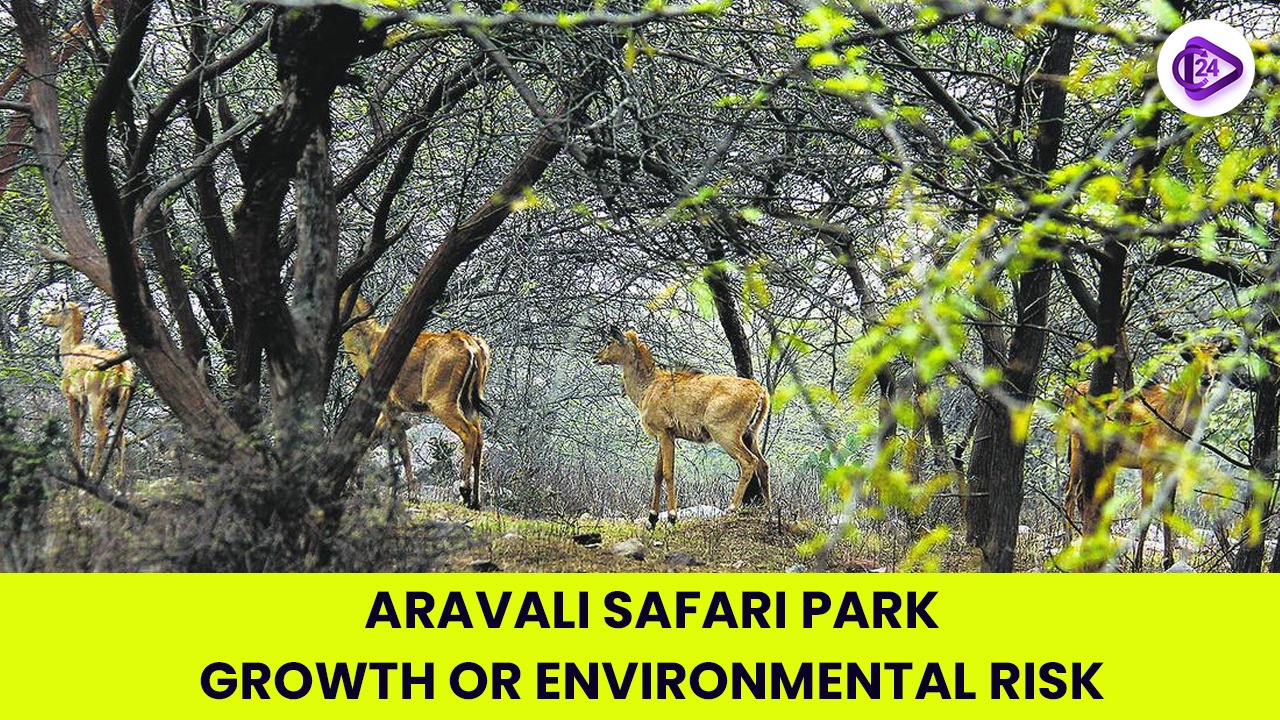
Haryana government planned the Aravali Safari Park as the global largest wilderness sanctuary by combining 3,858 hectares between Gurugram and Nuh districts for animal preserves and lodging establishments and recreational areas. Opposition has risen against the project because the Aravali hills serve essential environmental functions which include slowing progressive desertification and sustaining groundwater supplies and protecting wildlife habitats. Multiple experts have claimed that this project infringes upon forest regulations while endangering biodiversity conditions and intensifying the water shortage dilemma. The Forest Conservation Act along with the PLPA (1900) and Supreme Court court decisions provide legal defense to the region. A national park declaration for the territory instead of commercial safari development would be recommended by conservationists because it supports both sustainability and environmental conservation goals.
Introduction
-
The authorities in Haryana planned the construction of Aravali Safari Park across 3,858 hectares covering Gurugram and Nuh districts.
-
The proposed project aims to become the largest safari park on earth and includes numerous tourist-focused structures and resources such as enclosure facilities and dining and recreational features.
-
Even though it was originally promised in the polls the project faces significant resistance from environmental activists as well as former forestry officials.
Project Details
-
The Forest Department assumed responsibility for the project that started under the Haryana Tourism Department leadership.
-
The park covers areas that stretch from 11 villages in Gurugram totaling 2574 hectares to 7 villages in Nuh consisting of 1284 hectares.
Proposed components:
-
The planned facilities included animal cages in conjunction with botanical gardens and aquariums at the site.
-
Hotels, restaurants, and an open-air theatre.
-
Cable cars, tunnel walkways, and children’s parks.
-
An animal hospital and other tourist attractions.
Opposition to the Project
-
The Aravali hills function as a protective natural structure which forms the oldest fold mountain range while preventing desertification.
-
Highly water-stressed Gurugram and Nuh districts receive their recharge water supply through the natural rock formations of this area.
-
Because the Aravalis maintain numerous species of wildlife alongside their diverse plants the area requires urgent preservation efforts.
Legal Challenges:
-
The regulatory classification of this area designates it as forestry territory according to the definition of the Forest Conservation Act, 1980.
-
The Supreme Court together with the National Green Tribunal NGT has established barriers that restrict non-forest activities across these areas.
-
The forested area in Haryana represents just 3.6% of the land while the region needs wildlife restoration rather than commercial development.
-
Professional foresters among them comprising 37 retired Indian Forest Service (IFS) officers sent a letter to PM Modi which condemned the project for being primarily commercial rather than focused on conservation efforts.
Legal Protections for Aravali
-
Punjab Land Preservation Act (PLPA), 1900:
-
Section 4 and 5 of the law control active land utilization by stopping forest destruction.
-
-
Forest Conservation Act, 1980:
-
Under “forest” classification the law limits land use changes for activities outside forestry.
-
-
Supreme Court Judgment (T.N. Godavarman Case, 1996):
-
The dictionary definition of forests allows this legislation to protect both designated and unidentified forest areas under legal standards.
-
-
Regional Plan-2021 (National Capital Region):
-
Classifies Aravalis as a “Natural Conservation Zone (NCZ)”, restricting construction to only 0.5% of the area.
-
Recent Developments:
The government officially classified 24,000 hectares of Aravali territory as protected forest territory through an Indian Forest Act, 1927 designation to compensate for Nicobar Islands forest diversion.
Alternative Suggestions
-
Declare a National Park/Sanctuary:
-
The establishment of National Park or Sanctuary designation delivers the best way to protect the Aravalis while maintaining ecological balance in the region.
-
-
Sustainable Development Initiatives:
-
The regional government should encourage both eco-tourism development and forest reforestation initiatives rather than installing big-scale tourism enterprises.
-
-
Strict Implementation of Laws:
-
Existing forest conservation laws should have their enforcement strengthened in order to stop both illegal construction activities and deforestation.
-
Conclusion
The Aravali Safari Park attempts to generate tourism activity but it exposes the environment to substantial dangers. The united protection of Aravali territory as well as its ecological significance prevents the implementation of major infrastructure projects. Creating a national park as a conservation-oriented initiative would help fulfill sustainable development objectives and climate resilience targets.



 Rajasthan Bans Employment of Children Below 14 in Shops and Commercial Establishments
Rajasthan Bans Employment of Children Below 14 in Shops and Commercial Establishments India's First Glass Suspension Bridge, Bajrang Setu, Will Redefine Rishikesh Tourism by 2025
India's First Glass Suspension Bridge, Bajrang Setu, Will Redefine Rishikesh Tourism by 2025 NITI Aayog’s ‘We Rise’ Empowers Women Entrepreneurs
NITI Aayog’s ‘We Rise’ Empowers Women Entrepreneurs Harsh Sanghavi Appointed Gujarat Deputy Chief Minister in Major Cabinet Reshuffle
Harsh Sanghavi Appointed Gujarat Deputy Chief Minister in Major Cabinet Reshuffle India Ranks 102nd in Global Hunger Index 2025: Hunger Remains a Serious Challenge
India Ranks 102nd in Global Hunger Index 2025: Hunger Remains a Serious Challenge Kaziranga Director Sonali Ghosh Becomes First Indian to Win IUCN Innovation Award
Kaziranga Director Sonali Ghosh Becomes First Indian to Win IUCN Innovation Award Assam Government Introduces CM-FLIGHT Scheme for Improved Global Career
Assam Government Introduces CM-FLIGHT Scheme for Improved Global Career India’s First Bullet Train to Launch by August 2027, Mumbai–Ahmedabad
India’s First Bullet Train to Launch by August 2027, Mumbai–Ahmedabad Goa Launches Majhe Ghar Housing Regularisation Scheme
Goa Launches Majhe Ghar Housing Regularisation Scheme IUCN Recognizes India’s First Dugong Conservation Reserve in Tamil Nadu
IUCN Recognizes India’s First Dugong Conservation Reserve in Tamil Nadu






